Ditapis dengan
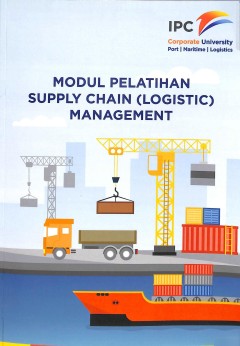
Modul Pelatihan : Supply Chain (Logistic) Management
This module is an introductory to Supply Chain Management, anad part of module of FIATA Higher Diploma in Supply Chain Management
- Edisi
- -
- ISBN/ISSN
- -
- Deskripsi Fisik
- 92 p., 29.5 cm.
- Judul Seri
- -
- No. Panggil
- IPC GUI SUP s

The logistics and supply chain toolkit : over 90 tools for transport, warehou…
- Edisi
- -
- ISBN/ISSN
- 978-0-7494-6808
- Deskripsi Fisik
- xi, 313 p, 22 cm
- Judul Seri
- -
- No. Panggil
- LO RIC t
- Edisi
- -
- ISBN/ISSN
- 978-0-7494-6808
- Deskripsi Fisik
- xi, 313 p, 22 cm
- Judul Seri
- -
- No. Panggil
- LO RIC t
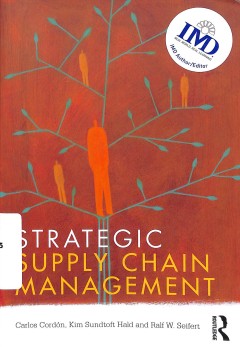
Strategic supply chain management
The supply chain is at the heart of every successful business organization's decision-making process. This textbook explains how to create a winning supply chain management strategy by spotlighting how senior executives in European and US companies have turned their supply chains into strategic weapons designed to convert threats, risks and outside pressures into competitive advantages. Strate…
- Edisi
- -
- ISBN/ISSN
- 978-0-415-59176-8
- Deskripsi Fisik
- ix, 278 p., ; 24 cm
- Judul Seri
- -
- No. Panggil
- LC 658.785 COR s

Managing logistics and supply chain challenges : singapore insights and persp…
Strategically located in Asia, Singapore has built on its geographical advantage to become one of the world s leading logistics hubs and a preferred location for leading manufacturers to establish regional distribution centres. Its world-class infrastructure, excellent connectivity, efficient customs, pro-business environment, educated workforce and stable government have made Singapore a compe…
- Edisi
- -
- ISBN/ISSN
- 978-981-4524-865
- Deskripsi Fisik
- xx, 467 p, 23 cm
- Judul Seri
- -
- No. Panggil
- LC 658.785 WEN m

GREEN LOGISTICS STRATEGY FOR SOUTH EAST EUROPE: TO IMPROVE INTERMODALITY AND …
This article describes the trend towards European green initiatives in the transport sector. The introduction of green logistics management and green policy in Europe has been analysed to understand better the positive impact of green policy on environment, society and economy. With the most recent EU initiatives in the field of green logistics, intermodality has become the platform for green l…
- Edisi
- 2012 Volume 27(1): 25-33
- ISBN/ISSN
- 1648-3480
- Deskripsi Fisik
- 10 p.
- Judul Seri
- GREEN LOGISTICS STRATEGY FOR SOUTH EAST EUROPE
- No. Panggil
- ATC LO BES g

Establishing an order allocation decision support system via learning curve m…
Apparel firms confront the problem with effective order allocation among factories when conducting global logistics operations. The problem is non-deterministic polynomial-time hard and often complicated to obtain an optimal solution. This research tried to solve, by heuristic method, the problem via applying the learning curve to the capacity planning to improve the decision-making on global l…
- Edisi
- Vol. 31, No. 5, 274–285
- ISBN/ISSN
- -
- Deskripsi Fisik
- 13 p.
- Judul Seri
- Journal of Industrial and Production Engineering
- No. Panggil
- ATC LO CHE e

Halal logistics: the role of ports, issues and challenges
- Edisi
- Vol. 5 Iss 3
- ISBN/ISSN
- -
- Deskripsi Fisik
- 15 p.
- Judul Seri
- Advances in Islamic Finance, Marketing, and Management
- No. Panggil
- ATC MG AZI h
- Edisi
- Vol. 5 Iss 3
- ISBN/ISSN
- -
- Deskripsi Fisik
- 15 p.
- Judul Seri
- Advances in Islamic Finance, Marketing, and Management
- No. Panggil
- ATC MG AZI h
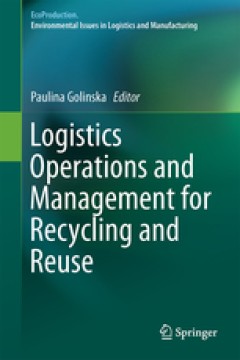
Logistics operations, supply chain management and sustainability
- Edisi
- -
- ISBN/ISSN
- 978-3-319-07287-6
- Deskripsi Fisik
- -
- Judul Seri
- -
- No. Panggil
- TXT LO Gol l
- Edisi
- -
- ISBN/ISSN
- 978-3-319-07287-6
- Deskripsi Fisik
- -
- Judul Seri
- -
- No. Panggil
- TXT LO Gol l
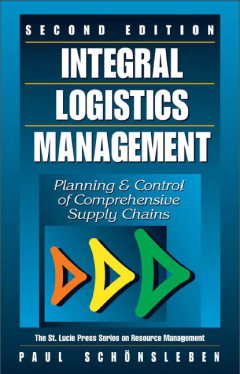
Integral logistics management: planning and control of comprehensive supply c…
- Edisi
- -
- ISBN/ISSN
- 1-57444-355-0
- Deskripsi Fisik
- -
- Judul Seri
- -
- No. Panggil
- TXT LO Sch i
- Edisi
- -
- ISBN/ISSN
- 1-57444-355-0
- Deskripsi Fisik
- -
- Judul Seri
- -
- No. Panggil
- TXT LO Sch i
Advances in Maritime Logistics and Supply Chain Systems
Over the recent years, maritime logistics and supply chains have witnessed tremendous growth rates around the world, notwithstanding the recent economic downturn. Maritime transportation accounts for the majority of international trade and it has become a vital factor for the economic health of many nations. In emrging economies, more new ports have also been developed to tap into the global ma…
- Edisi
- -
- ISBN/ISSN
- 978-981-4329-85-9
- Deskripsi Fisik
- xiii, 213p
- Judul Seri
- -
- No. Panggil
- TXT LO CHE a
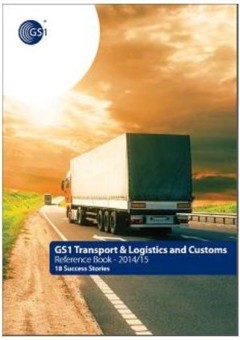
GS1 Transport & Logistics and Customs
Welcome to the GS1 Reference Book for Transport & Logistics (T&L) and Customs. Through this collection of stories, players around the world share their experiences of how GS1 Standards are truly making a difference in their operations. You will learn about their initiatives, best practices and “what’s working” when integrating standards into transport, logistics and Customs processes. Usi…
- Edisi
- -
- ISBN/ISSN
- -
- Deskripsi Fisik
- 56 pages
- Judul Seri
- -
- No. Panggil
- TXT LO GS1 g

Introduction to Logistic Systems Planning & control
- Edisi
- -
- ISBN/ISSN
- -
- Deskripsi Fisik
- xxiii, 339p
- Judul Seri
- -
- No. Panggil
- TXT LO GHI i
- Edisi
- -
- ISBN/ISSN
- -
- Deskripsi Fisik
- xxiii, 339p
- Judul Seri
- -
- No. Panggil
- TXT LO GHI i

Pengembangan Sistem Logistik yang Efisien dan Efektif dengan Pendekatan Suppl…
- Edisi
- -
- ISBN/ISSN
- -
- Deskripsi Fisik
- 8 p
- Judul Seri
- -
- No. Panggil
- ATC LO DED p
- Edisi
- -
- ISBN/ISSN
- -
- Deskripsi Fisik
- 8 p
- Judul Seri
- -
- No. Panggil
- ATC LO DED p

A Methodology For Logistics Strategy Planning
- Edisi
- -
- ISBN/ISSN
- -
- Deskripsi Fisik
- 19 p
- Judul Seri
- The International Journal of Logistics Management
- No. Panggil
- ATC LO RUS a
- Edisi
- -
- ISBN/ISSN
- -
- Deskripsi Fisik
- 19 p
- Judul Seri
- The International Journal of Logistics Management
- No. Panggil
- ATC LO RUS a

3PL Factories or Lernstatts? Value-Creation Models For 3PL Service Providers
Purpose – The purpose of this paper is to identify and systematically discuss generic forms of contract logistics services and their distinct underlying approaches for fulfilling their respective value propositions. A general frame of reference is developed that addresses the value proposition, as well as the value creation architecture that leads to generic business model configurations f…
- Edisi
- Vol. 42 Iss 6 pp
- ISBN/ISSN
- 0960-0035
- Deskripsi Fisik
- 20 p
- Judul Seri
- International Journal of Physical Distribution & Logistics Management
- No. Panggil
- ATC LO PRO t

Logistics and Supply Chain Education and Jobs: A Study of UK Markets
Purpose – The purpose of this paper is to examine the curriculum design of logistics and supply chain management (LSCM) undergraduate courses offered by selected UK higher education (HE) institutions and compares them with employers’ job requirements in the UK. Design/methodology/approach – Desk-based research involving content analysis of 22 selected undergraduate LSCM courses from 1…
- Edisi
- Vol. 25 Iss 3 pp
- ISBN/ISSN
- 0957-4093
- Deskripsi Fisik
- 2014
- Judul Seri
- The International Journal of Logistics Management
- No. Panggil
- ATC LO WON l

Logistics Management and Supply Chain Management: A Critical Evaluation
The purpose of this research is to identify the content of Logistics Management and Supply Chain Management, as perceived by course instructors and textbook content, and identify the core subjects of the discipline. The study is based on review and content analysis of two samples; 30 syllabi used for teaching a basic course, and 10 textbooks that are dedicated to the discipline. A list of be…
- Edisi
- Vol. 3, No. 2
- ISBN/ISSN
- -
- Deskripsi Fisik
- 7 p
- Judul Seri
- International Journal of Business and Economics Research
- No. Panggil
- ATC LO GLO l

Using a “Virtual Joint Venture” to Facilitate the Adoption of Intermodal …
Purpose – This paper aims to examine a strategic alliance between a large shipper and a freight forwarder to provide an intermodal service to and from the port of Gothenburg. The supply chain literature discusses various models of supply chain collaboration and integration. When applied to logistics, each has been shown to exhibit different levels of success depending on particular factors.…
- Edisi
- Vol. 20 Iss 5 pp
- ISBN/ISSN
- 1359-8546
- Deskripsi Fisik
- 16 p
- Judul Seri
- Supply Chain Management: An International Journal
- No. Panggil
- ATC LO MON u
Logistics composite modeling
Logistics is the collection of activities associated with acquiring, moving, storing and delivering supply chain commodities (i.e., products in all stages of manufacture, services and information). 1 Logistics encompasses the business functions of transportation, distribution, warehousing, material handling, and inventory management, and interfaces closely with manufacturing and marketing. Lo…
- Edisi
- -
- ISBN/ISSN
- -
- Deskripsi Fisik
- v, 47p
- Judul Seri
- -
- No. Panggil
- TXT LO RAT l
Transport Logistics shared solutions for common challange
The mission of the OECD Programme of Research on Road Transport and Intermodal Linkages (RTR) is to promote economic development in its Member countries by enhancing transport safety, efficiency and sustainability through a co-operative research programme on road and intermodal transport. To achieve this objective, the Programme recommends options for the development and implementation of effec…
- Edisi
- -
- ISBN/ISSN
- -
- Deskripsi Fisik
- 53 pages
- Judul Seri
- -
- No. Panggil
- TXT LO OEC t

Matches and gaps in the green logistics market
The interface between logistics service providers (LSPs) and shippers is an area that has received little attention in previous research and even less has been done when environmental issues are added to this interface. Nonetheless, the perception among researchers and the industry is that in many instances, supply and demand in this green interface does not coincide. The purpose of this paper …
- Edisi
- Vol. 42 No. 6, 2012 pp. 562-583
- ISBN/ISSN
- -
- Deskripsi Fisik
- 24 p.
- Judul Seri
- International Journal of Physical Distribution & Logistics Management
- No. Panggil
- ATC LO MAR m

Postponement Strategies for Channel Derivatives
- Edisi
- Vol. 11 Iss 1 pp. 19 - 36
- ISBN/ISSN
- -
- Deskripsi Fisik
- 20 p.
- Judul Seri
- -
- No. Panggil
- ATC LO AND p
- Edisi
- Vol. 11 Iss 1 pp. 19 - 36
- ISBN/ISSN
- -
- Deskripsi Fisik
- 20 p.
- Judul Seri
- -
- No. Panggil
- ATC LO AND p

Tax aligned global supply chains: Environmental impact illustrations, legal r…
Both logisticians and tax lawyers design global supply chains – but based on different logics. If they do not align each other’s perspectives, problems might occur in different areas. The purpose of this paper is to illustrate the impact the tax system could have on supply chain design, reflect (from both perspectives) on how the rules function, and propose a common communication platform f…
- Edisi
- Vol. 41 No. 9, 2011 pp. 878-895
- ISBN/ISSN
- -
- Deskripsi Fisik
- 20 p.
- Judul Seri
- International Journal of Physical Distribution & Logistics Management
- No. Panggil
- ATC LO NOR t

Tax aligned global supply chains: Environmental impact illustrations, legal r…
Both logisticians and tax lawyers design global supply chains – but based on different logics. If they do not align each other's perspectives, problems might occur in different areas. The purpose of this paper is to illustrate the impact the tax system could have on supply chain design, reflect (from both perspectives) on how the rules function, and propose a common communication platform for…
- Edisi
- Vol. 41 Issue: 9, pp.878-895
- ISBN/ISSN
- -
- Deskripsi Fisik
- 20 p.
- Judul Seri
- International Journal of Physical Distribution & Logistics Management
- No. Panggil
- ATC LO HEN t

Diffusion of green supply chain management: Examining perceived quality of gr…
Extant research has yielded conflicting results regarding the relationship between adoption of green supply chain management (GSCM) practices and competitive advantage. The purpose of this paper is to further investigate this relationship by examining the case of green reverse logistics (GRL).
- Edisi
- Vol. 22 No. 3, 2011 pp. 373-389
- ISBN/ISSN
- -
- Deskripsi Fisik
- 20 p.
- Judul Seri
- The International Journal of Logistics Management
- No. Panggil
- ATC LO HAN d

The Handbook of Logistics and Distribution Management: Understanding the Supp…
Now in its fifth edition, The Handbook of Logistics and Distribution Management covers the full scope of logistics and distribution, providing a broad strategic framework for planning as well as a clear and straightforward description of the basic functions and elements. This definitive handbook clearly explains: concepts of logistics and distribution; planning and logistics; procurement and…
- Edisi
- 5th ed.
- ISBN/ISSN
- 978-0-7494-6627-5
- Deskripsi Fisik
- xxix, 689p. ; 25cm.
- Judul Seri
- -
- No. Panggil
- LO RUS h

Building the extended enterprise: key collaboration factors
The purpose of this paper is to explore supply chain collaboration issues in the extended enterprise (EE) to develop a more complete understanding of the nature and effectiveness of collaboration in the transition towards, but also within, the EE paradigm.
- Edisi
- Vol. 22 No. 3, 2011
- ISBN/ISSN
- -
- Deskripsi Fisik
- 26 p.
- Judul Seri
- The International Journal of Logistics Management
- No. Panggil
- ATC LO BRA b
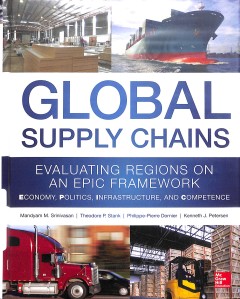
Global supply chains : evaluating regions on an EPIC framework
A proven framework for measuring the supply chain potential of geographic regions Managing a complex global supply chain requires a strategic assessment of the various factors that can affect decisions on procurement, manufacturing, warehousing, logistics, distribution, and sales. Co-written by renowned experts in global supply chain management, this book presents a systematic, structured appro…
- Edisi
- -
- ISBN/ISSN
- 978-0-07-179231-8
- Deskripsi Fisik
- xx, 476p.; 25cm.
- Judul Seri
- -
- No. Panggil
- TXT LO SRI g

Economies of speed in sea transportation
- Edisi
- Vol. 24 Iss 8 pp. 33 - 41
- ISBN/ISSN
- -
- Deskripsi Fisik
- 12 p.
- Judul Seri
- -
- No. Panggil
- ATC MR LAI i
- Edisi
- Vol. 24 Iss 8 pp. 33 - 41
- ISBN/ISSN
- -
- Deskripsi Fisik
- 12 p.
- Judul Seri
- -
- No. Panggil
- ATC MR LAI i

Logistical Business Continuity Planning-Scale Development and Validation
The International Journal of Logistics Management
- Edisi
- Vol. 20 Iss 3 pp
- ISBN/ISSN
- 0957-4093
- Deskripsi Fisik
- 20 p
- Judul Seri
- The International Journal of Logistics Management
- No. Panggil
- ATC LO OJH l

The New Logistics Management: Transformation Through Organizational Learning
- Edisi
- Vol. 8 Iss 1 pp
- ISBN/ISSN
- 0957-6053
- Deskripsi Fisik
- 12 p
- Judul Seri
- Logistics Information Management
- No. Panggil
- ATC LO DRE t
- Edisi
- Vol. 8 Iss 1 pp
- ISBN/ISSN
- 0957-6053
- Deskripsi Fisik
- 12 p
- Judul Seri
- Logistics Information Management
- No. Panggil
- ATC LO DRE t

A Structural Equation Model Assessment of Logistics Strategy
Purpose – The purpose of this paper is to assess relevance of the three dimensions (process strategy, market strategy, and information strategy) of the Bowersox and Daugherty typology to logistics strategy and organizational competitive outcomes. Design/methodology/approach – Empirical data gathered from US logistics managers were analyzed using second-order factor analysis to examine t…
- Edisi
- Vol. 22 Iss 3 pp
- ISBN/ISSN
- 0957-4093
- Deskripsi Fisik
- 24 p
- Judul Seri
- The International Journal of Logistics Management
- No. Panggil
- ATC LO KOH a

Horizontal logistics collaboration for enhanced supply chain performance: an …
The paper aims to develop a supply chain-driven model horizontal logistics collaboration (HLC). HLC initiatives can fail. To improve the chance of success, a thorough consideration of the potential issues involved, such as seeking supply chain partners’ support, ensuring access to information/data security and assessing whether an HLC model could bring improvements to a wide range of supply c…
- Edisi
- Volume 20 · Number 6 · 2015 · 631–647
- ISBN/ISSN
- -
- Deskripsi Fisik
- 18 p.
- Judul Seri
- Supply Chain Management: An International Journal
- No. Panggil
- ATC LO HAR h

Assessment of empty container repositioning policies in maritime transport
Empty container repositioning is an important issue in the liner shipping industry. Generally stated, two groups of mathematical models have been proposed to tackle this issue. The first group aims to derive time-dependent origin-destination matrices that specify the number of empty containers to be repositioned at a decision epoch; the second group aims to develop effective statefeedback contr…
- Edisi
- vol. 24
- ISBN/ISSN
- 0957- 4093
- Deskripsi Fisik
- 26 pages
- Judul Seri
- The International Journal of Logistics Management
- No. Panggil
- ATC MR DON a

Assessment of empty container repositioning policies in maritime transport
Empty container repositioning is an important issue in the liner shipping industry. Generally stated, two groups of mathematical models have been proposed to tackle this issue. The first group aims to derive time-dependent origin-destination matrices that specify the number of empty containers to be repositioned at a decision epoch; the second group aims to develop effective statefeedback contr…
- Edisi
- Vol. 24 No. 1, 2013 pp. 49-72
- ISBN/ISSN
- -
- Deskripsi Fisik
- 26 p.
- Judul Seri
- The International Journal of Logistics Management
- No. Panggil
- ATC LO PIN a

The impact on urban distribution operations of upstream supply chain constraints
The purpose of this paper is to investigate and quantify the impact of delivery restrictions on costs and environmental performance for a distribution operation.
- Edisi
- Vol. 41 Issue: 9, pp.896-912
- ISBN/ISSN
- -
- Deskripsi Fisik
- 19 p.
- Judul Seri
- International Journal of Physical Distribution & Logistics Management
- No. Panggil
- ATC LO BRO t

Retail supply chain management: key priorities and practices
The purpose of this paper is to investigate the unique supply chain strategies employed by retailers.
- Edisi
- Vol. 22 Issue: 3, pp.390-402
- ISBN/ISSN
- -
- Deskripsi Fisik
- 15 p.
- Judul Seri
- The International Journal of Logistics Management
- No. Panggil
- ATC LO DEF r

Mobile agent technology and application for online global logistic services
With the growing trend toward the use of international supply chain and e‐commerce, logistic service providers for product warehousing, transportation and delivery are placing great emphasis on information technology (IT) to be competitive globally. Realizing that the current service tracking system merely supports order status tracking within a service provider, applies mobile agent technolo…
- Edisi
- Vol. 104 Issue: 2, pp.169-183
- ISBN/ISSN
- -
- Deskripsi Fisik
- 18 p.
- Judul Seri
- Industrial Management & Data Systems
- No. Panggil
- ATC LO TRA m

Lean manufacturing: a perspective of lean suppliers
The main thrust of this paper empirically examines the connection between lean production and various aspects of the logistics system. This paper performs a comparison analysis to find whether significant performance/practice differences exist between lean suppliers and non-lean suppliers. The research findings indicate that, even given the same organizational constraints and resources, lean su…
- Edisi
- Vol. 23 No. 11, 2003 pp. 1349-1376
- ISBN/ISSN
- -
- Deskripsi Fisik
- 32 p.
- Judul Seri
- International Journal of Operations & Production Management
- No. Panggil
- ATC LO CHU l

Inter-firm customer knowledge sharing in logistics services: an empirical study
The purpose of this paper is to examine customer knowledge sharing between a buyer of a logistics service and the logistics service provider (LSP). The authors attempt to fill the gap in current research by investigating inter-firm customer knowledge sharing.
- Edisi
- Vol. 41 No. 10, 2011 pp. 956-971
- ISBN/ISSN
- -
- Deskripsi Fisik
- 18 p.
- Judul Seri
- International Journal of Physical Distribution & Logistics Management
- No. Panggil
- ATC LO MEH i

Impact of reverse logistics on supply chain performance
The purpose of this paper is to analyse the impact of reverse logistics on order and inventory variance amplification in a single-echelon supply chain (SC) and to propose a new order policy for dampening such amplification.
- Edisi
- Vol. 43 No. 7, 2013 pp. 564-585
- ISBN/ISSN
- -
- Deskripsi Fisik
- 24 p.
- Judul Seri
- International Journal of Physical Distribution & Logistics Management
- No. Panggil
- ATC LO TUR i

Global sourcing: process and design for efficient management
Although the literature on the strategic aspect of global sourcing is large, detailed studies on this procurement strategy from a process perspective are limited. This paper adopts the process viewpoint and examines the design and management issues associated with the global sourcing process based on a case study at a leading firm in the US aviation industry. The effectiveness of the company�…
- Edisi
- Vol. 8 Issue: 4, pp.367-379
- ISBN/ISSN
- -
- Deskripsi Fisik
- 15 p.
- Judul Seri
- Supply Chain Management: An International Journal
- No. Panggil
- ATC LO ZEN g

Explaining the effectiveness of performance-based logistics: a quantitative e…
Performance-based logistics (PBL) strategies are providing governments and for-profit organizations with a contractual mechanism that reduces the life cycle costs of their systems. PBL accomplishes this by establishing contracts that focus on the delivery of performance not parts. PBL establishes a metric based governance structure where suppliers make more profit when they invest in logistics …
- Edisi
- Vol. 22 No. 3, 2011 pp. 324-348
- ISBN/ISSN
- -
- Deskripsi Fisik
- 27 p.
- Judul Seri
- The International Journal of Logistics Management
- No. Panggil
- ATC LO HAW e

Evaluating six sigma methodology to improve logistical measures of food distr…
The purpose of this paper is to investigate the implementation of the Six Sigma methodology as a systematic business strategy and quality initiative to improve the critical logistical measures within small-to-medium-sized food distributors.
- Edisi
- Vol. 25 No. 7, 2014 pp. 998-1027
- ISBN/ISSN
- -
- Deskripsi Fisik
- 31 p.
- Judul Seri
- Journal of Manufacturing Technology Management
- No. Panggil
- ATC LO NAB e

Customer-specific adaptation by providers and their perception of 3PL-relatio…
The purpose of this paper is to investigate whether there is an impact, from a provider’s perspective, of customer-specific adaptations by third-party logistics (3PL) providers on the success of 3PL-relationships.
- Edisi
- Vol. 41 No. 9, 2011 pp. 822-838
- ISBN/ISSN
- -
- Deskripsi Fisik
- 19 p.
- Judul Seri
- International Journal of Physical Distribution & Logistics Management
- No. Panggil
- ATC LO KAT c

Availability of weapon systems with multiple failures and logistic delays
Maintaining a high level of availability of weapon systems during battles becomes important from the point of view of winning the battle. Due to attrition factors (failure due to battle damage and unreliability) and logistic delays in the repair process, maintaining the required level of availability is difficult. In this paper, we develop a simulation model for availability of fighter aircraft…
- Edisi
- Vol. 20 No. 7, 2003 pp. 836-846
- ISBN/ISSN
- -
- Deskripsi Fisik
- 13 p.
- Judul Seri
- International Journal of Quality & Reliability Management
- No. Panggil
- ATC LO SRI a

How to choose an effective third party logistics provider
The purpose of this article was to identify the steps that need to be taken when choosing an effective third party logistics provider. Based on the research completed, it was determined that third party logistics are beneficial to many companies. The use of third party logistics provides a competitive advantage in today’s business world. The optimal solution for a company choosing a third p…
- Edisi
- Vol. 26 Issue: 7, pp.50-58
- ISBN/ISSN
- -
- Deskripsi Fisik
- 12 p.
- Judul Seri
- Management Research News
- No. Panggil
- ATC LO AGH h

Improving the service operations of container terminals
In the relevant literature about container terminals (CTs), most studies focused on the internal operational management of CT operators. In practice, for improving the performance of CT operators, the external customers’ requirements should also be considered. The purpose of this paper is to discuss the improvement of service operations of CTs from users’ requirement perspectives.
- Edisi
- Vol. 24 No. 1, 2013
- ISBN/ISSN
- -
- Deskripsi Fisik
- 18 p.
- Judul Seri
- The International Journal of Logistics Management
- No. Panggil
- ATC LO HSU i

Logistics outsourcing interfaces: the role of customer partnering behavior
The purpose of this paper is to examine how the customer partnering behavior dimensions – operational information exchange, planning, sharing of benefits and burdens, and extendedness – influence goal achievement and goal exceedance at the interface between customer firms and their logistics service providers.
- Edisi
- Vol. 42 No. 6, 2012
- ISBN/ISSN
- -
- Deskripsi Fisik
- 20 p.
- Judul Seri
- International Journal of Physical Distribution & Logistics Management
- No. Panggil
- ATC LO GRA l
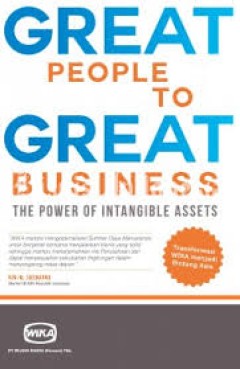
Managing Logistics and Supply Chain Challenges : Singapore Insights and Persp…
Strategically located in Asia, Singapore has built on its geographical advantage to become one of the world s leading logistics hubs and a preferred location for leading manufacturers to establish regional distribution centres. Its world-class infrastructure, excellent connectivity, efficient customs, pro-business environment, educated workforce and stable government have made Singapore a compe…
- Edisi
- -
- ISBN/ISSN
- 978-981-4524-86-5
- Deskripsi Fisik
- xxxiv, 467p. ; 23cm.
- Judul Seri
- -
- No. Panggil
- TXT LO ASS m
 Karya Umum
Karya Umum  Filsafat
Filsafat  Agama
Agama  Ilmu-ilmu Sosial
Ilmu-ilmu Sosial  Bahasa
Bahasa  Ilmu-ilmu Murni
Ilmu-ilmu Murni  Ilmu-ilmu Terapan
Ilmu-ilmu Terapan  Kesenian, Hiburan, dan Olahraga
Kesenian, Hiburan, dan Olahraga  Kesusastraan
Kesusastraan  Geografi dan Sejarah
Geografi dan Sejarah